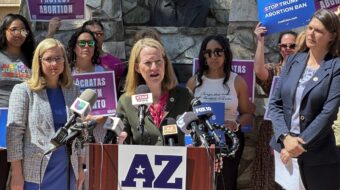
Arizona has seen its fair share of natural catastrophes this year. About three weeks after the breakout of the fierce Wallow Fire that burned the state’s woodlands, a giant dust cloud rolled over the city of Phoenix on July 5.
A report by AZFamily.com said this dust storm is regarded as one of “historic” proportions. At one mile high, 50 miles wide, and moving at nearly 30 mph, the storm overtook Phoenix at about 7:30 p.m. on Tuesday, leaving dust and debris in its wake, said AZ Central.
As the storm caused damage in various areas of the state – including blackouts in Tempe and, in one case, a small fire – the Phoenix Fire Department received around 700 calls for help throughout the night.
Overall, roughly 8,000 people have been left without power, and Phoenix-bound flights were delayed for many hours as visibility was reduced to zero.
Jeff Masters, a meteorologist at Weather Underground, notes that this storm had a higher amount of dust than usual for such storms, and says the amount of dust the storm carried could be attributed to the severe drought conditions the region has been experiencing.
A drought has gripped the Southwest for the past decade, according to the National Climatic Data Center.
Climate Central draws a link between the latest storm and climate change. It reports that scientists have predicted that rainfall will become increasingly scarce in the southwestern U.S. in the coming years. As a result, droughts will become more frequent in this region. So when the summer monsoon thunderstorms occur, they can whip up large amounts of dust off the dry ground, which would cause dust storms like the one seen on Tuesday.
Climate Central also reports on a study conducted by the U.S. Geological Survey which found that after a number of excessively dry and arid years in the Southwest, there was less plant life covering the ground. The same years that saw little plant growth also saw a rise in heavy dust-carrying winds. http://www.climatecentral.org/blogs/warmer-temperatures-could-bring-more-dust-to-the-southwest
“Vegetation on the ground helps keep soil intact,” Seth Munson, a USGS ecologist, told Climate Central. It “creates a buffer against the wind that blows through the area. So in years when there was a big decrease in the amount of plant cover, there was an exponential increase in wind erosion and dust production.”
Though Arizona has been battered with fire, smoke, and dust these past few weeks, a report at About.com said Phoenix in particular was a “safe city,” and generally not a victim of major environmental disasters.
In a Risk and Insurance magazine list of America’s safest cities in 2005, Phoenix was relatively high, said the report. According to the Greater Phoenix Economic Council, Phoenix held that spot because “its distance from the Atlantic and Gulf coasts [allows] for protection from hurricanes. In addition, the region rarely experiences major earthquake and tremor activity, with no deaths or injuries occurring from earthquakes in Arizona in the last century.”
The council did not mention wildfires or dust storms, and, of course, Risk and Insurance’s list dates from six years prior to the Wallow Fire.
The current dust storm is called a haboob. According to the Associated Press, a haboob is not incredibly unusual during this time of year, when Arizona’s annual monsoon season is in full swing.
This storm was, however, considered one of the all-time worst in the state.
Pail Iniguez of the National Weather Service told the New York Daily News, “This was pretty significant. We heard from a lot of people who lived here for a number of storms and this was the worst they’d seen.”
Dr. Julia Cole, professor of Geosciences at University of Arizona, told the Project on Climate Science, “What’s happening today in the Southwest should be a wake-up call on climate change. These are the kinds of conditions we expect to see more often as [the] climate warms.”
However, Munson, the USGS ecologist, suggested that people can do their part to help.
“We have a role in this,” he said. “We can take responsible land management practices into our hands that will help reduce the dust storm activity.”
Photo: A dust storm, or haboob, blows into Phoenix, Arizona in 2003. Junebug172 // Wikipedia












Comments